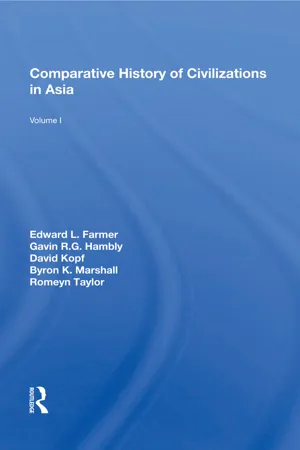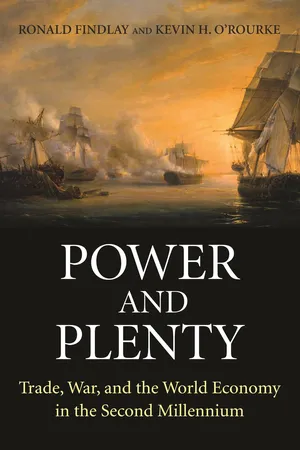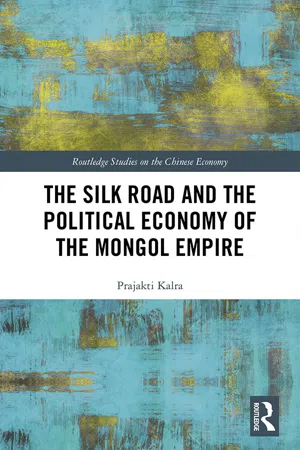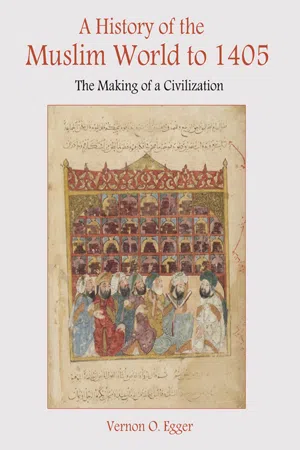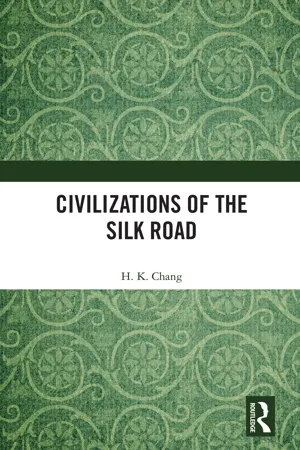History
Pax Mongolica
Pax Mongolica refers to the period of relative peace and stability across Eurasia during the height of the Mongol Empire in the 13th and 14th centuries. It facilitated increased trade, cultural exchange, and communication along the Silk Road, as well as the spread of ideas and technologies. The Mongol rule brought about a level of interconnectedness and prosperity across diverse regions.
Written by Perlego with AI-assistance
Related key terms
5 Key excerpts on "Pax Mongolica"
- eBook - ePub
- Edward L. Farmer(Author)
- 2019(Publication Date)
- Routledge(Publisher)
in the thirteenth century most of the Eurasian continent was brought under the rule of the Mongol empire. All the civilized societies and their Inner Asian oasis outposts had been continously involved in interaction with pastoral-nomadic peoples of the steppes. Frontier states had been formed as a result of the conquest of agricultural and town-dwelling people by the nomads and, at times, the civilized societies, by war and diplomacy, had brought large areas of the steppe under their political control. Moreover, for about two millennia and perhaps longer than that, the peoples of the steppe, despite their differences in language and ethnic background, developed a fairly uniform culture from one end of the Eurasian steppe to the other. This resulted from a number of factors, including similar adaptations to analogous environmental conditions and relationships with the civilized societies; large-scale and long-term migrations usually leading westward from Mongolia; and the incorporation of different combinations of pastoral peoples in tribes and tribal federations, which resulted in close cooperation and mutual adaptation among the groups involved. The formation of the immense Mongol empire marked the culmination of the processes of steppe-sown interaction and the political integration of pastoral-nomadic peoples. For the first time, the steppe peoples under unified command simultaneously brought the sedentary societies of West Asia, Eastern Europe, and East Asia under their rule. The Mongol conquests resulted in the devastation of many cities, the ruin of vast areas of agricultural land, and enormous loss of life. On the other hand, under their unified rule communications across the continent were easier than ever before, trade flourished, and with the exchange of populations among all civilized societies from Western Europe to the Pacific and Southeast Asia, cultural diffusion among civilizations occurred at an unprecedented rate.The Period
This chapter will focus on the formation of the Mongol empire under Chingiz Khan and its expansion to include the greater part of the Eurasian continent, from the Pacific coast to the Mediterranean, between ca. 1100 and ca. 1500. Consideration will also be given to the breakup of the Mongol empire and the formation of the spectacular, but short-lived, empire of Timur (Tamerlane), who tried to revive the universal empire of the Mongols.The ephemeral political integration of Eurasia under the Mongols was preceded by several developments tending towards a community of civilizations. The spread of the universal religions had created a measure of cultural and religious community that survived regional fragmentation within and among the civilizations. Overland and maritime trade generated mobile, cosmopolitan, commercial classes able to forge economic and, later, political links among the civilizations. Our own era of global politics was prefigured by the early attempts at high-level political cooperation, as between crusading Europe and the imperialist Mongols. The Mongol era was followed by that of the early modern empires, the subject of the following chapter. The Ottoman and Safavid empires in West Asia, the Mughuls in South Asia, Ming China, and Tokugawa Japan all were in some degree products of the disintegration of the Mongol empire and institutionally and culturally influenced by it. One might add Czarist Russia to the list, if this study were not limited to non-European Eurasia. - eBook - ePub
The Princeton Economic History of the Western World
Trade, War, and the World Economy in the Second Millennium
- Ronald Findlay, Kevin H. O'Rourke(Authors)
- 2009(Publication Date)
- Princeton University Press(Publisher)
While the traditional trade patterns between nomadic and sedentary peoples, such as the exchange of horses and camels for tea and silk, continued, the absence of imperial rule, even if only loosely unified between the different components of the Mongol Empire, had momentous geopolitical consequences that in turn had major repercussions on the future patterns of world trade. The end of the Pax Mongolica spelled the end of the relative ease with which European merchants had been able to move throughout Eurasia. Foreigners were expelled from China, and there were massacres of Europeans in Persia and Turkestan to name just two examples. Thus it was that “the eastern frontier of south European trade gradually receded from the sea of China to the edge of the Mediterranean, losing even there the secure shelters of the Italian commercial colonies,” and that European merchants found themselves once more dependent on “the Egyptian bottle-neck” (Lopez 1987, pp. 383, 387). Briefly, it seemed that the status quo ante might be restored by the great Central Asian conqueror, Timur (Tamerlane). Ethnically Turkic but politically affiliated with the Chaghatai Mongol Khans, he launched a series of attacks on surrounding areas, nomad and sedentary alike, causing great destruction and amassing a huge amount of plunder. His capital of Samarkand and other cities of the region were the beneficiaries of these fruits of conquest, reflected in splendid architecture and the construction of observatories and libraries. Adshead (1993) claims that there was an underlying logic to his apparently destructive activities, namely the securing of the southern Silk Road and the diversion of the caravan trade to this route from the alternative northern route controlled by the Golden Horde. His destruction of Sarai, the Horde’s capital on the Volga and the hub of its commerce, is explained as a calculated move to further this aim - Prajakti Kalra(Author)
- 2018(Publication Date)
- Routledge(Publisher)
5 Trade and economic relations in Mongol EurasiaThe Mongol conquest of China, most of Southwest Asia, and eastern Europe created a new empire of unparalleled power and extent. It united the eastern and western parts of Eurasia Into a single political order, facilitatingthe exchange of people, trade, and ideas.1The previous chapters have laid out the basis of Mongol Eurasia as a geographical place and a philosophical construct. The rise of Chinggis Khan and the rise of a united Eurasia under his descendants created a unique space which relied on providing interconnections, exchanges and contact. It included disparate regions, religions, peoples and political systems. Steppe traditions, Mongol institutions, religious policies and the construction and revival of cities as political and commercial centres contributed to the Mongol endeavour in Eurasia. The Mongol transformation of Eurasia and the Silk Road remains singular, unqualified and lasting. The impact of Mongol policies on the political systems and military has already been discussed. The third aspect of the economic transformation of Eurasia under the Mongols is the focus of this chapter. The chapter is divided between a discussion on trade in the economic system of the nomads, followed by economic relations in Eurasia, between and within the Khanates based on the use of established trade networks and the creation of new routes; and finishes with a discussion of a description of the diversity of goods traded along the Silk Road under the Mongols. The network of trade relations includes the special place of manufacturing in Mongol Eurasia. The Mongols as the true heirs of steppe tradition accorded a prominent place for artisans and skilled craftsmen in all four Khanates. The tradition of amassing the skilled population in court to express majesty, honour marriages, alliances and other important social events, was an old steppe custom which was passed down to the Mongols.2 It also helps make a much stronger case for Mongols as producers. The Mongols established a large number of workshops which earned kingly incomes.3 By far, Allsen’s work on Culture and Conquest in Mongol Eurasia and his wider research on trade under the Mongols, Yuan-Ilkhan exchanges and Mongol agency have been of the greatest help in the conceptualisation of this chapter. The attempt here is to highlight the varied and composite ways in which the Mongols attended to trade under Mongol unification: symbolic and physical. The unique underpinning of trade relations which looked beyond divisive lines of religion as discussed in Chapter 3 and the place of merchants in the administrative-bureaucratic complex of government analysed in Chapter 2- eBook - ePub
A History of the Muslim World to 1405
The Making of a Civilization
- Vernon Egger(Author)
- 2016(Publication Date)
- Routledge(Publisher)
The Mongols are not easy to dismiss as a destructive, one-time wonder, however. Despite the fact that they soon lost control of their possessions, their legacy was remembered, revered, and emulated for centuries thereafter throughout much of the vast region they had conquered. In western and central Europe, too, the legacy lingered, but in a peculiar fashion: Rumors that a great force to the east had brutalized part of the Muslim world during 1219–1222 sparked hope in Europe that a potential ally, perhaps even a Christian king, existed in the east that would help to destroy Islam. This was the origin of the legend of Prester John, a great Christian king in the East with whom the Europeans should join forces against Islam. The hope was so strong that when, in 1238, the Nizari Imam at Alamut and the Abbasid caliph in Baghdad jointly dispatched an embassy to Europe, appealing for help against the Mongols, they were rebuffed. Europe, particularly in the person of the Pope, was pursuing a diametrically opposed policy of attempting to form a great Christian alliance with the Mongol Great Khan—whom some thought to be Prester John—against the world of Islam. Even the crushing Mongol defeat of European knights three years later at Liegnitz did not dissipate the fantasy of Prester John, who continued to fascinate and lure Europeans for hundreds of years to come.But the Mongols were not only the stuff of memory and legend. They transformed the world. These horsemen from the steppes who destroyed so many cities quickly began to rebuild urban economies once they assumed power. Few of their leaders appear to have appreciated the importance of agriculture, and that sector usually languished as a result. Long-distance trade, on the other hand, flourished as never before. From the Pacific to the Black Sea, bandits were held in check, caravanserais were constructed, and diplomatic contacts were established. The famous career of the Venetian Marco Polo in the last third of the thirteenth century would be unthinkable without the Mongols. He and his father and uncle traveled from Constantinople to Beijing and back with less fear for their lives or property than they would have felt had they journeyed anywhere in the Mediterranean basin. Taking advantage of the Pax Mongolica, Venice quickly established a vast trade network that extended from the Pacific to Scandinavia.The Mongol Empire affected the histories of all its neighbors as well as of peoples beyond their immediate reach. The history of a large part of the Muslim world was irrevocably altered. The Mongols and their desperately ambitious scion Timur Lang dominated western Asia for only a century and a half, but Mongol hegemony had such a profound influence on the course of Muslim history that it merits a separate section in this book. Chapter 10 establishes the historical framework for the period. It examines the history of the three Mongol states whose rulers eventually converted to Islam, traces the rise of three other powerful Muslim states during this period, and explores the destructive effects of the plague and Timur Lang on western Asia. Chapter 11 examines the cumulative effects of these and other events on Muslim intellectual and religious life. The evidence undermines the widely held view that the Mongol era caused Islamic civilization to decline. Despite frequent outbreaks of political chaos and the long-lasting economic depression of some regions, Islamic culture continued to thrive and break new ground in a wide variety of fields. More striking still, the period marks a transition from an era of several centuries during which the frontiers of the Muslim world had remained largely static to an age of remarkable expansion. In many respects, the period of Mongol hegemony marks the beginning of a golden age of Muslim history. - eBook - ePub
- H. K. Chang(Author)
- 2023(Publication Date)
- Routledge(Publisher)
Eurasia Under Mongol RuleDOI: 10.4324/9781003369899-14There is a saying in academic circles today that real “world history” only began with the Mongol Empire (1206–1368).We have amply explored economic and cultural exchange between the eastern and western wings of Eurasia, as well as the migration of peoples, but these links and influences were indirect and often interrupted. Even the Battle of Talas, in which the Arab army ended the Tang Dynasty’s dominance and profoundly influenced the history of Central Asia, was essentially a random military encounter. It was the establishment of the Mongol Empire that initiated the establishment of concrete, practical ties— on the political level—between the two extremes of the Eurasian continent, and led to smooth and prosperous interactions.I have discussed the Ottoman Empire previously and will detail the Timurid Empire later. If we add the Ming, then we have identified the three great empires that co-starred during the 14th century—and all were closely associated with the Mongols. The Ming overthrew the Mongols and founded their own dynasty, while Timur was a Turkic-speaking emir of the Mongol ruling group. He emerged victorious from political infighting inside the Chagatai Khanate, and frequently interacted with the White Horde that was born of the division of the Kipchak Khanate of the Mongol group.During one of their Western Expeditions, the Mongols crushed the Seljuk Sultanate of Rûm, and this led to the division of its territory into many small states including the Ottoman principality. Meanwhile, the Russians in Eastern Europe were ruled by the Mongols for two centuries, and historically they perceived Ivan III’s victory in 1480 over the Mongol-Tatar forces as marking their liberation from the Mongol yoke. Therefore, even without querying whether globalization was initiated by the Mongols, the historical role of the Mongol Empire is a topic worthy of serious study.
Index pages curate the most relevant extracts from our library of academic textbooks. They’ve been created using an in-house natural language model (NLM), each adding context and meaning to key research topics.
